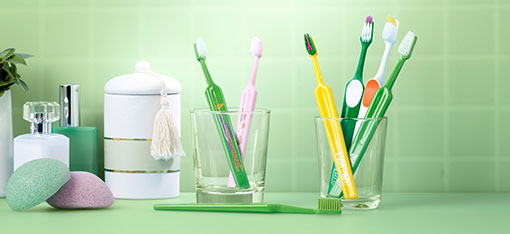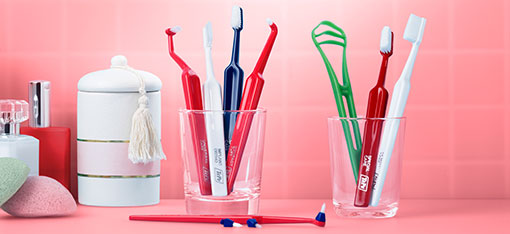Brushing Your Teeth
A good toothbrush is important to your daily oral health care routine. Dental plaque finds areas to hide in your mouth, for example, around crowded teeth or along the gumline. Dental plaque is a sticky film of bacteria that constantly forms on your teeth. It must be removed regularly, or it can cause gum inflammation, cavities, and bad breath. This month we are celebrating Dental Hygiene Month, as well as offering some tips and tricks for better brushing.
Every October is National Dental Hygiene Month. The American Dental Hygienists’ Association (ADHA) initiates a national campaign to celebrate and recognize the role dental hygienists play in improving the health of their patients, as well as spread awareness about the importance of oral health.

During this month the goal is to:
- Promote the value of oral health. Good oral health is essential for overall health, so this month is all about the importance of maintaining your healthy smile.
- Encourage you to evaluate your own oral home care routines. It is recommended to brush twice a day for 2 minutes and clean between your teeth once a day.
- Celebrate your dental hygienist. The role of the dental hygienist is aimed at prevention of oral disease with consideration on whole-body health. When you visit your dental professional, you may remember your hygienist completing oral disease screenings, cleaning your teeth, taking x-rays, or having conversations about how you can impact your own oral health through daily oral hygiene habits.
How to Brush Teeth
Here are 3 steps for proper brushing with a manual toothbrush.
- Look at the angle of the toothbrush. Place your toothbrush bristles towards your gums at a 45-degree angle so that the bristles sweep along the gumline. Look in the mirror to assure that you place the brush properly.
- Get the motion down. Slowly move the toothbrush around your mouth in small incremental back and forth motions. Brushing twice a day for 2 minutes is essential. You can do a sweeping motion on the side of each tooth or small circles but remember to focus where the tooth meets the gums, because this is where harmful bacteria that causes dental disease resides.
- Cover all the surfaces. It is important to brush all surfaces of your teeth. Having a sequential method will help ensure nothing is missed. Start on the inside, continue with the outside and finish by brushing the chewing surfaces.
Tips to Help You Brush Better
Do you think about the way you are brushing your teeth every day or is it more of an automatic procedure? Here are some simple tips to make your brushing more effective.
- Review your technique. Generally, most plaque accumulates along the gumline and between the teeth. When brushing the goal is to feel the bristles along the gumline. Aim to angle your toothbrush at about 45 degrees, so the bristles sweep along the gums and then slowly move in a back-and-forth motion around the mouth. Slightly open your mouth, and only focus on a couple teeth at a time while you count 1, 2, 3, and then move the toothbrush to the next couple teeth.
- When brushing your back teeth, slightly close your mouth. Although this may sound counterintuitive, when you open wide you will contract the muscle in your cheek that sits along your back teeth. If you close slightly and relax the muscle, you allow the toothbrush the space needed to reach those back teeth without getting stopped by your cheek muscle.
- Slow down when brushing. We often brush way too fast. It is recommended to brush your teeth for two minutes, so if you are not sure how much time you are spending on brushing—time yourself! Again, focus on a couple teeth at a time for a few seconds before moving onto the next teeth.
- Create a sequence for brushing to not miss any surfaces. It is important to brush all surfaces of your teeth. Having a sequential method will help ensure nothing is missed. Depending on your dominant hand, you are probably going to start your brushing on the opposite side of your mouth. For example, right-handed people will start brushing on the left side of their mouth on the cheek side of the tooth. We tend to be very aware of our brushing technique in the beginning and then go on autopilot as we continue to brush. So, why not start in areas that are more difficult to brush and then leave the easier-to-reach areas for last, when we have most likely switched to autopilot brushing? For example, start brushing those hard to reach inside surfaces of your teeth, continue with the outside and finish by brushing the chewing surfaces.
TePe Toothbrushes Designed for Daily Care
TePe offers different sizes of toothbrushes for the different stages of life. Every TePe brush and been designed with the help of Dental Professionals to deliver the highest quality and most effective toothbrushes for both adults and children. The toothbrushes are efficient, durable, and easy to use.

TePe Supreme™: The TePe Supreme™ toothbrush has an innovative bristle design, along with a tapered brush head. The multi-level bristles enable more efficient cleaning further in between the teeth and along the gumline with the longer bristles. The tapered brush head allows access to reach the back teeth. It has an easy-grip handle with a thumb pad. The toothbrush neck can be angled without heating. Available in regular and compact brush head sizes, and bristle texture extra soft, soft or medium.

TePe Nova™: The Nova™ toothbrush is designed with an easy-reach tip for access in hard-to-reach areas, especially around the back teeth. The tapered brush head allows access to reach the back teeth. It has an easy-grip handle with a thumb pad. The toothbrush neck can be angled without heating. Available in regular brush head size, and bristle texture extra soft, soft or medium.


TePe GOOD™: TePe GOOD™ toothbrush is a unique brush with the same TEPe quality, design and feeling as always, but made from 96% bio-based plastic. Thanks to the use of the renewable raw materials such as sugar cane and castor oil, we now manage to recirculate up to 95% of the carbon dioxide emissions during its life cycle. Available in mini, compact and regular brush head size, and bristle texture extra soft or soft depending on brush head size.

TePe Select™: TePe Select™ toothbrush features a user-friendly handle, a tapered brush head for improved access and end-rounded bristles for a gentle cleaning. The toothbrush neck can be angled using got water for even better access. Available in regular and compact brush head sizes, and bristle texture extra soft, soft or medium.

TePe Kids™: TePe Kids™ is suitable for children after 3 years of age. With a compact brush head and short handle, brushing is simple and develops healthy, clean smiles. Keep your kids engaged with fun designs along the handle. The toothbrush neck can be angled using got water for even better access. Available in a compact brush head size, and bristle texture extra soft or soft.

TePe Mini™: The TePe Mini™ toothbrush is developed for use from the first tooth until 3 years old. The tapered mini brush head has extra soft bristles for a gentle cleaning. The handle provides a stable grip for the adult brushing the child’s teeth but fits just as well in the small hand of the child. The toothbrush neck can be angled using got water for even better access.











Leave a comment